History
GRANDMASTER SHUM LEUNG 岑亮
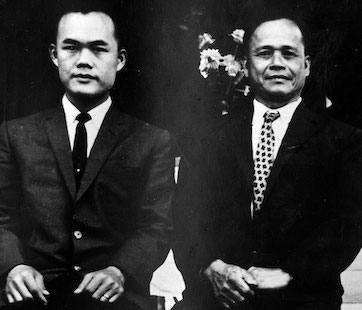 Sifu Shum started studying martial arts at the age of eight
with Ng Wai Nung, his godfather,
who had a small school in Kowloon and who trained his godson in both kung fu and tai chi. Sifu Shum practiced with his godfather until he was sixteen.
When Ng Wai Nung was asked to teach Eagle Claw in Singapore for three years, Sifu Shum and his training brother, Shum Man Lock, were put in charge
of the school until his return. When Ng Wai Nung returned from Singapore, Shum Man Lock went to Canton. Sifu Shum then helped his teacher until
leaving for the United States in 1971.
Sifu Shum started studying martial arts at the age of eight
with Ng Wai Nung, his godfather,
who had a small school in Kowloon and who trained his godson in both kung fu and tai chi. Sifu Shum practiced with his godfather until he was sixteen.
When Ng Wai Nung was asked to teach Eagle Claw in Singapore for three years, Sifu Shum and his training brother, Shum Man Lock, were put in charge
of the school until his return. When Ng Wai Nung returned from Singapore, Shum Man Lock went to Canton. Sifu Shum then helped his teacher until
leaving for the United States in 1971.
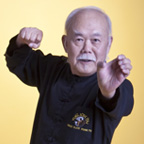 When Sifu Shum came to this country he knew no one. He worked in a restaurant in Chinatown,
little by little widening his circle of friends and teaching privately. In 1972 Master Wai Hong of the Tiger Claw system (Fu Jaw Pai) organized a tournament and invited Sifu Shum
to perform and act as a judge.
Don Larkin, Sifu Shum's first American student, was in the audience. He was so impressed with Sifu Shum that he sought him out and asked Sifu Shum to
teach him. He took private lessons from Sifu Shum for about one year, then in March 1974, helped Sifu Shum open the first Eagle Claw school in America
on 28th Street In New York City. It was the beginning of the school's American history.
When Sifu Shum came to this country he knew no one. He worked in a restaurant in Chinatown,
little by little widening his circle of friends and teaching privately. In 1972 Master Wai Hong of the Tiger Claw system (Fu Jaw Pai) organized a tournament and invited Sifu Shum
to perform and act as a judge.
Don Larkin, Sifu Shum's first American student, was in the audience. He was so impressed with Sifu Shum that he sought him out and asked Sifu Shum to
teach him. He took private lessons from Sifu Shum for about one year, then in March 1974, helped Sifu Shum open the first Eagle Claw school in America
on 28th Street In New York City. It was the beginning of the school's American history.
History of Fan Zi Ying Jaw Pai.
Originally the Eagle Claw system, whose complete history is told in Sifu Shum's book "Eagle Claw Kung Fu: Classical Northern Chinese Fist", was called Elephant style, a system of hand combat that Ngok Fei (Yue Fei), said to be the most brilliant general of the Southern Song dynasty (1127-1279 AD), taught to his soldiers. The Song court had fled south of the Huai river, a tributary of the Yang Tse River, before the Jürched (a Siberian people who were the ancestors of the Manchus, the last rulers of China before the country became a Republic), w ho had conquered North China. The Song court set up its capital in Hang Chow. General Ngok Fei defeated the Jürched every time he fought them. Just hearing Ngok Fei's name filled the Jürched with terror. Ngok Fei was able to win victory after victory because he was a clever tactician, and above all because of the kung fu system he taught to his troops.
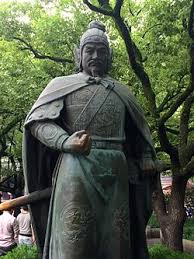 Ngok Fei (Yue Fei) was a junior officer who rose from the ranks of recruits.
He was not only an excellent strategist, but also a scholar and always showed moral integrity and loyalty to the Emperor. He inspired discipline among his troops,
won the people's support, succeeded in suppressing bandits who were roaming the land, and defeated the Jürched cavalry with infantry tactics.
Ngok Fei (Yue Fei) was a junior officer who rose from the ranks of recruits.
He was not only an excellent strategist, but also a scholar and always showed moral integrity and loyalty to the Emperor. He inspired discipline among his troops,
won the people's support, succeeded in suppressing bandits who were roaming the land, and defeated the Jürched cavalry with infantry tactics.
Unfortunately for Ngok Fei (Yue Fei), at that time Prime Minister Ch'in Kwei was working out a peace settlement with the Jürched. Ngok Fei's integrity and popularity were not only jeopardizing the peace accord, but also threatening a shaky regime, the Emperor being a lackluster ruler. Ch'in Kwei falsely accused Ngok Fei of insubordination and convinced the Emperor to order him back to the capital. Ngok Fei, who knew very well what was waiting for him, refused to obey. Three times he disregarded the imperial command. Finally the Emperor sent him a "gold edict" - an order that could not be ignored under penalty of death. Ngok Fei had no choice: he headed back to the capital. Once there, he was immediately thrown into prison where he was murdered. He was thirty-nine. It is widely believed that Ch'in Kwei engineered Ngok Fei's murder.
Ngok Fei's soldiers, enraged at the grossly unfair punishment he had suffered, disbanded and continued training on their own. A monk named Lai Chin, who was already the master of his own system called Faan Tzi, happened to see Ngok Fei's former soldiers training during his travels. He recognized the value of their techniques and decided to incorporate them into his own system. Faan Tzi Eagle Claw was born: today it is known as the Northern Eagle Claw system.
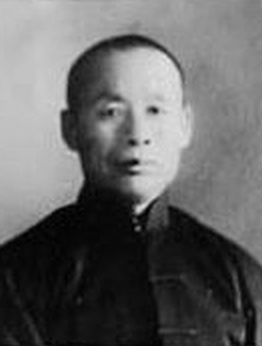 Lai Chin taught Northern Eagle Claw to his student, another monk named Toa Gai, who in turn passed it on to one of his lay students, Lau Shing Yuo.
The latter trained his son, Lau Kai Man (picture on the right), in the system. Originally, the Northern Eagle Claw system was to remain within the Lau clan and was not to be taught to outsiders.
But Lau Kai Man taught it not only to his nephew in the Lau family, Lau Fat Man, but also to Chan Tzi Ching, his sister's son.
Lai Chin taught Northern Eagle Claw to his student, another monk named Toa Gai, who in turn passed it on to one of his lay students, Lau Shing Yuo.
The latter trained his son, Lau Kai Man (picture on the right), in the system. Originally, the Northern Eagle Claw system was to remain within the Lau clan and was not to be taught to outsiders.
But Lau Kai Man taught it not only to his nephew in the Lau family, Lau Fat Man, but also to Chan Tzi Ching, his sister's son.
Chan Tzi Ching founded the Ching Mo Kung Fu Association in Shanghai with his friend, Fawk Yun Gop. Other sifus soon joined the association. Chan Tzi Ching also went to Hong Kong to set up another Ching Mo Association, but he soon had to return to Shanghai and left the Hong Kong Ching Mo Association in the care of Lau Fat Man. Sifu Shum's teacher (our Sigong), Ng Wai Nung, trained extensively under Lau Fat Man.
During the Sino-Japanese War (1937-1945), the Hong Kong Ching Mo Association was closed. Lau Fat Man spent the war teaching in Canton with Ng Wai Nung. After the war, Lau Fat Man went back to Hong Kong and taught for five years in the Restaurant Workers' Union. Ng Wai Nung also came back and taught in an opera actors' club and gave private lessons in both kung fu and tai chi.
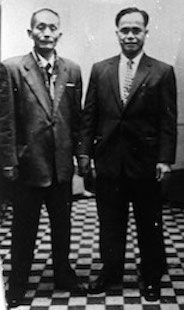 Later Ng Wai Nung opened a school on Tai Po Road in Kowloon, where he taught until his death in 1992.
Picture of Lau Fat Man with Ng Wai Nung is on the left.
Later Ng Wai Nung opened a school on Tai Po Road in Kowloon, where he taught until his death in 1992.
Picture of Lau Fat Man with Ng Wai Nung is on the left.
Great-Grandmaster Lau Fat Man also opened a school and later taught privately until his death in the mid-1960's. His daughters, Lily and Gini Lau still carry on their father’s art.
Some additional information published on Taiping Institute of Singapore web site. According to the Yuejia Pu (Yue Family Annals), Yue Fei studied some straightforward striking methods, these are considered as the basics of BaFanMen, and to this day have been named Yue Jia Chui (Strikes of the Yue Family). Yue Jia Chui are the basics on which the latter style of Yue Jia Quan in the South (Hubei, Jiangxi provinces) is based upon, it is also the fundamentals of Ba Fan Men (also known as Ba Shan Fan, or Fanzi Quan).
Bafanmen (Fanzi Quan) is quite an ancient style with its origins in Song dynasty. It was a highly influential style across the Central Plains mixing with many other methods and is the mother of Ying Zhao Fanzi (Eagle’s Claw) and was instrumental in the development by Li Luoneng (who had studied some of its methods) of Hebei Xing Yi Quan (thus the differences from the older Dai Family Xinyi and Xinyi Liuhe methods).
Such a long history is difficult to trace so from the available records
(the various family Quanpu or Boxing Manuals) we can determine key lineages commencing from the Ming Dynasty. Below we will provide information only relevant
to Yingzhao Fanzi (Eagle Claw Fanzi Quan).
Facheng (法成) taught elements of Fanzi to Liu Shijun (Lai Chin ) called "Lian quan", who then combined with Ying Zhao Chin-na (or Yue Shi Sanshou). Liu Shijun (刘士俊) was from Xiong County, Hebei Province and taught Liu Chengyou (Lau Shing Yuo), Liu Dekuan, Xu Liu, Ji Zixiu, Ji De, Li Zhengsheng and others. Liu Shijun (Lai Chin ) was responsible for the development of the basic methods of Ba Fan Men including the Yuejia Chui being harnessed into the "Lian quan" (linked fists) methods of Eagle Claw.
Liu Chengyou (刘成有 , Lau Shing Yuo) was from Guzhuangtou Village in Xiong County, Hebei Province. When he started trainig he first was introduced to the rudiments of boxing by "Flying Kicks" Yang JIngshan. He later studied with Liu Dekuan and Dong Xianzhou in Bafanzi Quan followed by further studies with Liu Shijun directly. Through his experiences Liu Chengyou enhanced the system by expanding the 36 locking methods into 108 Qin Na, which became the key feature of the Eagle Claw branch. The key disciples of Liu Chengyou were Liu Qiwen, Chen Zicheng and Zhang Zhanwen.
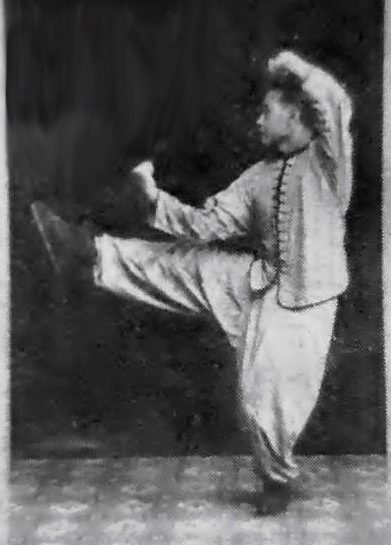 Cheng Zicheng (陈子正, Chan Tzi Ching, 1878-1933) also known as Chen Jiping, was from Lilin Village in Xiong County, Hebei Province.
He studied boxing methods since his youth and became a disciple of Liu Chengyou. Cheng Zicheng was known as the "Eagle's Claw King" and became an accomplished martial artist.
He joined the Chin Woo Association (Jing Wu) and was sent to Hong Long to teach in their representative branch, he was also later asked to go to Singapore
and not longer after his arrival was challenged by some british boxers in competition. After defeating him he was recognized by Indonesia and awarded a dagger
with the inscriptions " Chinese Boxing King". In addition to teaching, he did much to compile the Fanziquan system,
including writings and developments such as compiling the "Lian quan" (Lin kuen) into a series of "Xing quan" (Hung Kuen, moving fists) which were in 10 sequences
(now has become 12 and up to 14 in some branches).
Cheng Zicheng (陈子正, Chan Tzi Ching, 1878-1933) also known as Chen Jiping, was from Lilin Village in Xiong County, Hebei Province.
He studied boxing methods since his youth and became a disciple of Liu Chengyou. Cheng Zicheng was known as the "Eagle's Claw King" and became an accomplished martial artist.
He joined the Chin Woo Association (Jing Wu) and was sent to Hong Long to teach in their representative branch, he was also later asked to go to Singapore
and not longer after his arrival was challenged by some british boxers in competition. After defeating him he was recognized by Indonesia and awarded a dagger
with the inscriptions " Chinese Boxing King". In addition to teaching, he did much to compile the Fanziquan system,
including writings and developments such as compiling the "Lian quan" (Lin kuen) into a series of "Xing quan" (Hung Kuen, moving fists) which were in 10 sequences
(now has become 12 and up to 14 in some branches).
As an important teacher of the Chin Woo Association it allowed the style to be well promoted and spread globally. Many new forms were created on the basis of other styles taught at the association and the style became a new system referred to as Ying Zhao Fan Zi Men or simply Ying Zhao Pai (Eagle's Claw). In Hong Kong his key disciple was Liu Fawen (Lau Fat Man, also his martial brother as the nephew of Liu Qiwen) who was responsible for the Chin Woo Activities in Hong Kong after Cheng Zicheng returned to Shanghai.
History of Eagle Claw in USA
Sifu Leung Shum open the first Eagle Claw school in America on 28th Street In New York City in March 1974. It was the beginning of the school's American history. Over the years, thousands of students have learned and practiced the Eagle Claw system. Some have studied for more than thirty years, others only a few months, but all of them have benefited from the teaching of our Sifu. Now, the next generation of students (his students' students and their children) is coming of age and carrying on the Eagle Claw legacy. More about history you may find at Shum's Eagle Claw international headquarters web site.